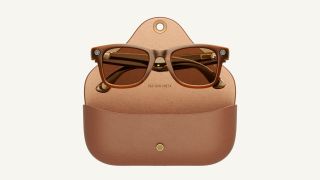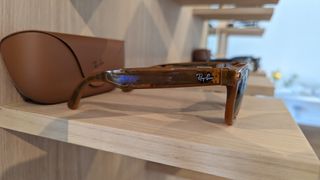The Ray-Ban Stories 2 is here with a new design, new specs, and a new name
We knew Meta Connect 2023 would be the time when Meta would finally tell us everything we needed to know about the soon-to-be-released Meta Quest 3 VR headset, but that’s not the only XR gadget up Meta’s sleeve. It also introduced us to Ray-Ban’s latest smart glasses collaboration (available to pre-order now from £299, US and Australian prices to be confirmed) and I got to try them out.
This sequel to the Ray-Ban Stories might not be called the Ray-Ban Stories 2 – officially it’s known as the Ray-Ban Meta Smart Glasses Collection (a mouthful, I know) – but it might as well be a sequel can be . Meta has improved everything from the internal components to the case design, while retaining everything that makes Ray-Ban Stories what they are.
The first improvement is the camera of the Ray-Ban Meta smart glasses. It now features a 12MP snapper instead of 5MP, which captures higher resolution photos and videos than before. The 32GB internal storage can store up to 500 photos or 100 30-second videos. The microphone system has also been upgraded, and Meta says the five-mic setup is better at capturing immersive spatial audio.
You’ll probably find that the speakers are better, too. According to Meta, the open-ear speakers in each arm are 50% louder than those in Ray-Ban Stories. Additionally, Meta promises that they can deliver deeper bass and greater clarity and cause fewer audio leaks (making it harder for people to hear what you’re listening to).
A new useful feature is the addition of a simple voice assistant. You can tell it to take a photo or video, or if your Ray-Ban Meta smart glasses are connected wirelessly to a phone, you can ask the assistant to call someone from your contacts and send them a photo of where you are. are.
The design has also been updated. You can still buy a pair in the classic Wayfarer style (regular or large) or you can buy them in the new Headliner style created for this collaboration. Each frame type is compatible with a range of different lens styles, from prescription to polarized, and you can customize the frames with five different colors: glossy black, matte black, transparent black, transparent turquoise, or transparent orange. Thanks to all these options, there are over 150 different combinations, so you should be able to find the Ray-Ban Meta smart glasses you’re looking for.
The new specs will ship on October 17, and pre-orders are now live. The Ray-Ban Meta Smart Glasses collection starts at £299 (US and Australian prices yet to be confirmed). If you want to buy a pair with Transitions or polarized lenses, it will cost you a little more, £379 and £329 respectively (US and Australian prices yet to be confirmed).
You can check out my full hands-on review of the Ray-Ban Meta Smart Glasses Collection for my in-depth thoughts on Meta x RayBan’s new smart specs, but long story short: these glasses seem good, if a little a niche.
Images and videos I shot with the glasses look great – and their hands-free nature makes it easy to capture moments that wouldn’t fit holding a phone in your hand. I also agree with Meta that the glasses allowed me to capture a memory and at the same time feel more active than if I were recording with my phone.
The sound of the glasses also seems solid. I haven’t had the opportunity to hear as wide a range of tracks as would be necessary for a full review, but my first impressions are that they offer good clarity and volume, although I’m not sure the sound is that powerful as I love. As for audio leakage, this seems controlled. I had my demo at the same time as someone else and when their music was at moderate loudness and mine was off, I couldn’t hear what they were playing even though I was standing quite close.
My biggest concern is that the glasses feel a bit niche-like. Ideally you’d wear this as often as possible to enjoy music wherever you go, or to take a photo or record of whatever improvised moments you come across – but I’m not sure the people around me will love that I carry a striking camera everywhere I go.
Sure, I could carry them in their charging case and only take them out when I need them, but why not just use my phone? Even mid-range phones have a better camera of 50 MP+.
When I need both hands free or I want to feel more involved in the moment, I can pull out one of the best action cameras, many of which are cheaper or only slightly more expensive than these specs. And for a similar music experience, you could purchase air conduction headphones such as the JBL Soundgear Sense.
That said, I’m admittedly not very familiar with this category of glasses. My experience is with specs like the Xreal Airs, which focus on AR video rather than a built-in camera. I imagine that over a longer test I’d find a use case for these RayBan glasses that would make them feel less niche.
If you can already see how these glasses fit your lifestyle, they may be a worthwhile purchase. But if you can’t think of a good use for it, maybe think twice about getting your pre-order in.



